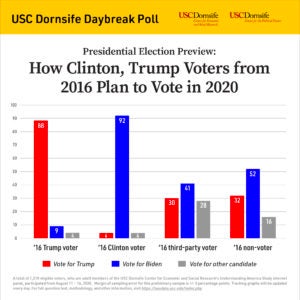The new version of USC’s groundbreaking “Daybreak Poll” will provide three ways to estimate how Americans may vote in the 2020 presidential election. Results will be posted on the poll’s daily tracking website in the coming weeks.
Contact: Jenesse Miller, (213) 810-8554 or jenessem@usc.edu or Jim Key, (213) 821-2992 or jameskey@dornsife.usc.edu
Two centers at the USC Dornsife College of Letters, Arts and Sciences have launched a daily nationwide poll to track Americans’ opinions about the presidential candidates. USC researchers will base election forecasts on an updated version of methods used in their groundbreaking 2016 election poll which tracked crucial inflection points in the election by following the same individuals over time. Data from the 2016 USC poll suggested late-breaking support among certain groups that contributed to Donald Trump’s surprise win in the electoral college.
“Our 2016 Daybreak poll was the USC debut of experimental polling methods pioneered by our team at RAND in 2012,” said Jill Darling, survey director of the 2020 Daybreak Poll which is conducted by the USC Dornsife Center for Economic and Social Research. “We adjusted our model for the 2018 election and had great success predicting the congressional outcome. This election cycle we’ll be using that model, and two additional methodologies, to track voter support for presidential candidates. We are also asking voters which party’s candidate they’ll vote for in congressional races.”
Results are based on repeated participation of eligible voters in the USC probability-based panel, the Understanding American Study, which is a probability-based representative sample of U.S. households. The researchers expect that more than 6,000 voters from their panel will respond to the poll every two weeks, with shifts in the data reflecting changing opinions.
The first full release of findings from the poll will be in late August, when researchers will examine the impact of the pandemic on voters and take a look at differences between voting blocs in 2016 and 2020. An early peek at preliminary data among roughly 1,500 respondents who participated from August 11 to August 16, using the poll’s signature probability method, finds Democratic nominee Joe Biden holding an 11 point lead over President Trump.
Three methods of estimating how America plans to vote
The poll is partially funded by the National Science Foundation through a collaboration between USC, the Santa Fe Institute, and MIT, led at USC by Wändi Bruine de Bruin, who is Provost Professor of Public Policy, Psychology, and Behavioral Science in the USC Price School of Public Policy and the Dornsife College.
The partnership also includes the USC Center for Economic and Social Research and the USC Center for the Political Future. The latter is led by two of the nation’s most experienced political experts representing both sides of the political divide, Robert Shrum and Michael Murphy.
“This is the election of a lifetime. By polling thousands of people and polling every night, our tracking will give us a real time read on the shifting direction of the presidential and congressional races,” said Robert Shrum, co-director of the Center for the Political Future and Carmen H. and Louis Warschaw Chair in Practical Politics.
“This poll will add a lot to our understanding of the Presidential race. Tracking data allows us not only to see what has been happening in the presidential race, but also what might be coming next,” said Mike Murphy, co-director of the Center for the Political Future.
The 2020 version of the USC Dornsife Daybreak Poll will use three ways of estimating how America plans to vote in the November election:
- The probability-based method used in 2016 and again in 2018.
- Asking participants how they expect people in their social circles and state will vote.
- Asking respondents whom they would vote for if the election were held today. This question includes third-party candidates for the Green and Libertarian parties, and the option of saying that they remain undecided.
The three models will provide differently calculated estimates of where the national popular vote stands today. These results will be updated daily in the tracking poll graphs, along with the estimated vote in red, blue and swing states, in urban, rural and suburban areas of the country, and by political affiliation on the poll’s tracking website, which will be available online in the coming weeks.


